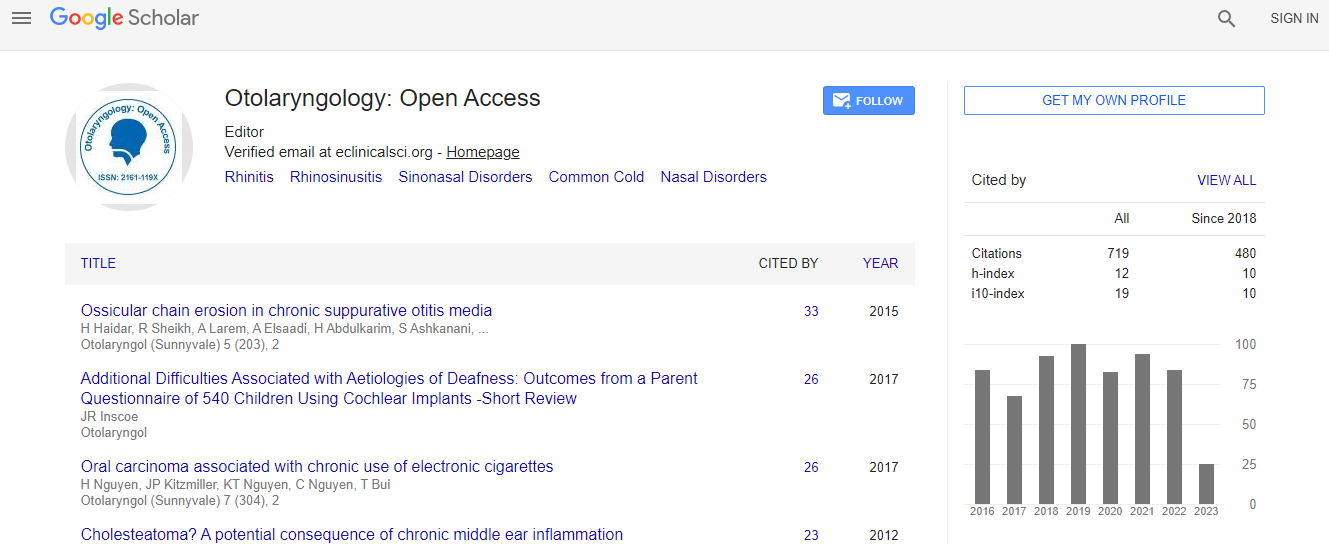Our Group organises 3000+ Global Conferenceseries Events every year across USA, Europe & Asia with support from 1000 more scientific Societies and Publishes 700+ Open Access Journals which contains over 50000 eminent personalities, reputed scientists as editorial board members.
Open Access Journals gaining more Readers and Citations
700 Journals and 15,000,000 Readers Each Journal is getting 25,000+ Readers
Google Scholar citation report
Citations : 925
Otolaryngology: Open Access received 925 citations as per Google Scholar report
Otolaryngology: Open Access peer review process verified at publons
Indexed In
- Index Copernicus
- Google Scholar
- Sherpa Romeo
- Open J Gate
- Genamics JournalSeek
- RefSeek
- Hamdard University
- EBSCO A-Z
- OCLC- WorldCat
- Publons
- Geneva Foundation for Medical Education and Research
- ICMJE
Useful Links
Recommended Journals
Related Subjects
Share This Page
Sequential bilateral cochlear implantation in children
International Conference and Exhibition on Otolaryngology
Henrik Strom-Roum
ScientificTracks Abstracts: Otolaryngology
Abstract
Studies on children with sequential bilateral implantation has shown that these children may have the possibility to take an advantage of the binaural benefits of normal-hearing individuals. However, reports are limited by concerns about the number of patients and the observation times. In our study we included prelingually deaf children with sequential bilateral cochlear implantation assessed at both 12 and 24 months postoperatively to the second implantation.We evaluated the effect of bilateral versus unilateral cochlear implants and the importance of the inter-implant interval (time between the first and the second implantation) on speech recognition and sound localisation performance. Seventy-three children was tested using monosyllabic words in quiet conditions and 63 children performed the five-speaker sound localisation test. Percent correct word perception, mean angular error (MAE) and correct speaker score (CSS) was calculated The mean bilateral speech recognition 12 and 24 months after the second implantation was significantly higher than that obtained with either the first or the second implant alone. The overall improvement (both 12 and 24 months postoperatively the second implantation) in the MAE with two cochlear implants compared with one cochlear implant was 10.18 %. After 12 months with bilateral CIs, the difference in CSS between listening in a unilateral (mean CSS = 29%) condition and listening in bilateral (mean CSS = 30%) condition was small, however a significant difference was seen after 24 months, mean bilateral CSS 38%. A shorter inter-implant interval was associated with better bilateral speech recognition and sound localising performance.Biography
Dr. Str?m-Roum work as an assistent professor, clinical ENT and research fellow at University of Oslo and Division of Surgery and Clinical Neuroscience Department of Otorhinolaryngology, Oslo University Hospital, Norway. He is a part of the Cochlear Implant Unit and has presented at several international conferences. Special field of interest in Otolaryngology is coch lear implants and Pediatric audiology.

 Spanish
Spanish  Chinese
Chinese  Russian
Russian  German
German  French
French  Japanese
Japanese  Portuguese
Portuguese  Hindi
Hindi 
